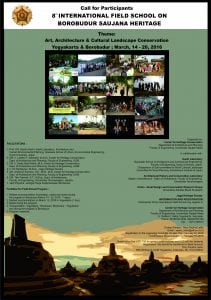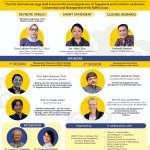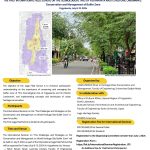BACKGROUND
Saujana heritage or cultural landscape heritage is the inextricable unity between nature and manmade heritage in space and time, or the variety of interactive manifestation between manmade heritage and natural environment. The interaction of nature and culture has become a new perspective in global discourse of sciences especially those which concern with heritage conservation started in the end of the 80’s. However, in the Indonesian higher education as well as the discourse on the saujana has not well developed. Whereas in fact, Indonesia from Sabang to Merauke is a mosaic of one of the world’s largest diversity of saujana that needs interdisciplinary developed.
Borobudur Temple compound, which consists of Borobudur, Mendut and Pawon Temples, was inscribed in the UNESCO’s World Heritage List No. 592 in the year 1991. The area of this compound has rich of natural and cultural potentials associated with the establishment of the temples existence. There are surrounding mountains, ancient lake, fertile soil, and rural atmosphere as well as everyday community life of traditional villages which performs the value and variety of interactive manifestation between manmade heritage and natural environment called saujana. The existence of archaeological remains, particularly temples, give identity to Borobudur area as a historic area, a place of the construction of archaeological artefacts in 8-9 Century. Those temples showed the high culture of the community in the past which today become educational values.
The interaction between the landscape and community culture over space and time units is mirrored in the physical features of the Borobudur villages, including the traditional architecture of the area, and unique community cultural traditions (agriculture activity in traditional way, local craft making, daily life of the people, beliefs, and arts) that are inherited from generation to generation. The rich potencies of the landscape and culture of Borobudur, and also the strong unity of them, make this area an outstanding cultural landscape heritage.
However, since saujana is in a dynamic environment that always changes with time, Borobudur saujana heritage has experienced many changes, both in its landscape and culture. On the other hand, the management and conservation efforts of Borobudur saujana heritage have many constrains, due to the lack of understanding on its potential and outstanding values. In the last decade, there has been a tremendous movement of the local communities to be more concerned on the unbalance conservation and development of this World Cultural Heritage Sites.
In order to response the comprehensive needs, in scientific as well as practical, on the conservation of Borobudur cultural landscape, since 2004, the International Field School of Borobudur Cultural Landscape Heritage Conservation (shortly named Borobudur Field School/BFS) has been annually organized by the Center for Heritage Conservation, Department of Architecture and Planning, Gadjah Mada University in collaboration with Kanki Laboratory for Architecture and Human Environmental Planning, Graduate School of Urban Environmental Engineering, Kyoto University, Japan; Miyagawa Seminar, Dept. of Environmental System, Wakayama University, Japan; and Jogja Heritage Society.
Every year, each BFS has emphasized on specific implementing techniques of cultural landscape conservation, including enhancing participants’ skill on the inventory, documentation and presentation some unique villages surrounding Borobudur Temple which are ignored in the Borobudur Temple conservation and development (1st BFS); developing village design guidelines (2nd BFS); emphasizing on the formulation of village design guidelines (3rd BFS); emphasizing on the various principles and issues on the regional context of Borobudur conservation planning (4th BFS); deeply learn various principles and issues on regional conservation planning of Borobudur (5th BFS); and emphasizing on participants’ skill in implementing techniques of saujana heritage conservation in the context of Borobudur as a National Strategic Area (6th BFS). The last BFS (7th BFS) was conducted in 2013, the year that was marked as the Indonesian Heritage Year 2013 with the theme of “Heritage for Community Welfare”. The 7th BFS was focused on describing saujana heritage from the viewpoint of the local communities’ initiatives and to deeply discuss the new academic idea of ‘Dynamic Authenticity’ and ‘Evolutive Conservation’ generated from those initiatives. The next BFS (8th BFS) will be conducted in 2016 which will focus on the high role of local arts and architecture in Borobudur saujana heritage conservation.
Those above mentioned programs have exhibited that each program had each own topic from micro to macro scale, from village to regional context. However, the focal point of Borobudur saujana heritage learning process has been the local community initiatives. Heritage conservation is likely a cultural movement. The involvement of the local community is an important aspect in resolving conservation through a bottom-up planning approach and support people as the center of conservation management.
THEME
Arts, Architecture, and Cultural Landscape Conservation
OBJECTIVES
The objective of the Eight Borobudur Field School program in a specific theme is emphasized on enhancing participants’ understanding on the high role of arts and architecture in saujana (cultural landscape) heritage conservation, and implementing concepts and techniques of saujana heritage conservation focusing on the local arts and architecture.
In detail, the objectives of the Borobudur Field School program are:
- To give participants a comprehension on conservation and management of Borobudur saujana, including historical buildings, traditional building architecture, setting and culture systems, living culture and other natural environmental components.
- To give participants understanding on the local arts and architecture and their roles in Borobudur saujana heritage conservation.
- To enhance participant skill in implementing concepts, methods, conservation process and landscape management in the actual cases.
- To enhance participants on implementing techniques of saujana heritage conservation, including inventory, documentation, analysis, and formulation of local arts and architecture conservation guidelines.
- To give participants experience in doing a research on saujana conservation with local arts and architecture as the focus directly in the field.
PARTICIPANTS
The 8th International Borobudur Field School is limited to 25 participants, they are:
- Students from Indonesian or overseas universities who have concerns on cultural landscape heritage conservation.
- Lecturers, researchers from Indonesia or overseas universities with interdisciplinary sciences related to the program topic
- Parties who have concerns on cultural landscape heritage conservation (individuals, government, cultural and heritage associations, arts associations, environmental associations, tourism experts, etc).
TIME AND VENUE
The program is organized for 7 days (March 14-20, 2016) in Yogyakarta as well as Borobudur area, Magelang Regency, Central Java. Participants will depart together from Gadjah Mada University, Yogyakarta to Borobudur on March 14, 2016. During the program, participants will stay in a modest accommodation in Yogyakarta and home-stays in Candirejo Village, Borobudur Sub-District.
REGISTRATION AND FEE
Participants of the International Borobudur Field School may register to:
Center for Heritage Conservation
Department of Architecture and Planning, Faculty of Engineering, Universitas Gadjah Mada
Jl. Grafika 2, Sekip Yogyakarta, Indonesia. Telp. 62 274 544910. Fax: 62 274 580852
Contact Person: Yeny Paulina Leibo, E-mail: yeyen_leibo@yahoo.co.id
Registration to the Organizing Committee not later than February 10, 2016
Confirmation of participation by February 15, 2016
Registration fee USD 750 for general public/scholar and USD 600 for students.
Registration fee should be transferred to Bank Account:
Yeny Paulina Leibo,
BNI 46 Branch UGM Yogyakarta, Indonesia, No. 0134104532
Call for Participants of 8th BFS 2016
For more update, please visit our gallery : http://chc.ft.ugm.ac.id/gallery/365/




